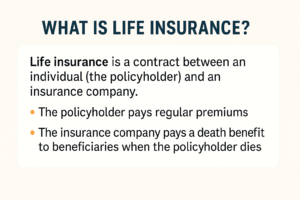life insurance what is life insurance
life insurance
💼 What Is Life Insurance?
Life insurance is a contract between you (the policyholder) and an insurance company. In exchange for regular payments (called premiums), the insurer agrees to pay a lump-sum amount (called the death benefit) to your chosen beneficiaries if you pass away during the policy term.
🛠️ How Does Life Insurance Work?
You Buy a Policy
Choose the type of policy (term or permanent), coverage amount (e.g., ₹50 lakh or $250,000), and duration (e.g., 10, 20, or 30 years).
You Pay Premiums
Premiums can be paid monthly, quarterly, annually, or in a lump sum.
Premium amount depends on your age, health, lifestyle, occupation, and coverage amount.
If You Pass Away While the Policy Is Active
The insurance company pays the death benefit to your beneficiary (spouse, children, etc.).
This money can be used for any purpose: daily living expenses, mortgage, education, debts, or funeral costs.
If You Outlive the Policy (for term insurance)
There’s no payout (unless it’s a return-of-premium policy).
For whole life or endowment policies, you may get a cash value or maturity benefit.
🧾 Types of Life Insurance
| Type | Key Features | Ideal For |
|---|---|---|
| Term Insurance | Low premium, fixed term, no maturity benefit | Affordable income protection |
| Whole Life | Lifetime coverage + cash value component | Long-term wealth transfer |
| Endowment Plan | Combines insurance with savings/maturity return | Saving for future goals (marriage, kids) |
| ULIP | Life cover + investment (market-linked) | Investment-savvy individuals |
✅ Why Buy Life Insurance?
Family protection (financial support after your death)
Loan repayment (mortgages or personal loans)
Tax benefits (under Section 80C & 10(10D) in India)
Wealth transfer or estate planning
Peace of mind
Key Takeaways
✅ What It Is
Life insurance is a financial safety net that pays a lump sum to your beneficiaries if you die during the policy term.
🛠️ How It Works
You pay premiums (monthly/annually).
The insurer pays a death benefit if you pass away while the policy is active.
📦 Types of Life Insurance
Term Insurance – Affordable, pure protection for a fixed period.
Whole Life Insurance – Lifetime coverage with cash value.
Endowment Plans – Life cover + savings (with maturity payout).
ULIPs – Life cover + market-linked investment.
💡 Why It Matters
Protects your family’s future income.
Helps cover debts, education, and funeral costs.
Offers tax benefits in many countries.
Can be a part of retirement or estate planning.
What is Life Insurance?
Life insurance is a contract between an individual (the policyholder) and an insurance company. In this agreement, the insurance company promises to pay a predetermined sum of money—called a death benefit—to the policyholder’s beneficiaries (such as family members) when the policyholder dies.
In return, the policyholder agrees to pay regular premiums (monthly, quarterly, or annually) to keep the policy active.
🧾 In Simple Terms:
Life insurance is a way to ensure that your loved ones are financially protected if something happens to you.
👨👩👧👦 Why People Buy Life Insurance:
To provide income replacement for dependents (spouse, children, parents)
To cover debts (like home loans, car loans, credit cards)
To pay for funeral or medical expenses
To leave a financial legacy or fund a child’s education
For tax planning or estate management
What Is a Life Insurance Policy?

A life insurance policy is a legal contract between you (the policyholder) and an insurance company. It outlines the terms and conditions under which the insurer agrees to pay a death benefit to your chosen beneficiary if you pass away while the policy is in force.
🔍 Key Components of a Life Insurance Policy:
| Term | Meaning |
|---|---|
| Policyholder | The person who owns the policy and pays the premiums |
| Insured Person | The person whose life is covered (often the same as the policyholder) |
| Beneficiary | The person(s) who receive the payout upon the insured’s death |
| Premium | The regular payment made to keep the policy active |
| Death Benefit | The sum paid to the beneficiary upon the insured’s death |
| Policy Term | The length of time the policy provides coverage |
| Riders | Optional add-ons (e.g., critical illness, accidental death benefits) |
🛠️ What Does a Policy Include?
The coverage amount (sum assured)
The term length (e.g., 10, 20, or 30 years)
The premium amount and frequency
Any exclusions (e.g., suicide within first year)
Claim procedure for beneficiaries
💡 In Short:
A life insurance policy is your written promise of financial protection for your family. If you meet all terms (by paying premiums and not violating conditions), your loved ones receive a tax-free payout if you pass away.
What Are the Types of Life Insurance?
📦 Types of Life Insurance
Life insurance comes in several types, each designed to meet different financial goals, risk appetites, and life stages. Here’s a breakdown of the main types:
1. Term Life Insurance
🔹 Pure protection plan for a fixed period (10, 20, 30 years)
🔹 If you die during the term, your nominee receives the death benefit
🔹 No payout if you survive the term (unless return-of-premium is added)
✅ Most affordable form of life insurance
Best for: Income protection for family, mortgage coverage
2. Whole Life Insurance
🔹 Covers you for your entire lifetime
🔹 Includes a cash value component that grows over time
🔹 Premiums are higher but stay fixed
✅ Can be used for wealth transfer or estate planning
Best for: Lifetime financial protection + savings growth
3. Endowment Plans
🔹 Combines insurance + savings
🔹 Pays out death benefit if you die during the term
🔹 Pays a maturity benefit if you survive the term
✅ Low-risk option with guaranteed returns
Best for: Goal-based savings (child’s education, marriage, retirement)
4. Unit Linked Insurance Plans (ULIPs)
🔹 Combines life cover + market-linked investment
🔹 Part of your premium is invested in equity/debt funds
🔹 Returns depend on market performance
✅ Flexible and transparent, with tax benefits
Best for: Long-term investors comfortable with market risk
5. Money Back Plans
🔹 Offers periodic payouts during the policy term
🔹 Pays out full sum assured + bonuses on maturity/death
✅ Helpful for regular liquidity needs
Best for: People looking for insurance + guaranteed cash flow
6. Group Life Insurance
🔹 Coverage provided to employees or members of an organization
🔹 Lower premiums due to bulk coverage
✅ Supplemental to personal insurance
Best for: Employee benefit packages
Advantages of Life Insurance
✅ Advantages of Life Insurance
Life insurance provides more than just peace of mind—it offers practical financial benefits to you and your loved ones. Here are the key advantages:
1. Financial Protection for Family
🔹 Your dependents receive a lump-sum death benefit in the event of your death
🔹 Helps cover daily living expenses, children’s education, and outstanding debts
2. Income Replacement
🔹 Replaces lost income if the main earner passes away
🔹 Ensures that your family can maintain their standard of living
3. Debt Coverage
🔹 Helps pay off loans, mortgages, credit cards, or other liabilities
🔹 Prevents your family from being burdened with your financial obligations
4. Tax Benefits
(In countries like India under Section 80C & 10(10D))
🔹 Premiums are tax-deductible
🔹 Death/maturity benefits are usually tax-free
5. Peace of Mind
🔹 Knowing your loved ones are financially protected brings emotional and mental comfort
6. Savings + Investment (for certain policies)
🔹 Endowment and ULIP policies offer returns on maturity
🔹 Can be used for long-term goals like retirement, marriage, or a child’s education
7. Customizable Coverage
🔹 Add-on riders like critical illness, accidental death, disability, etc.
🔹 You can tailor the plan to your needs
8. Estate Planning & Wealth Transfer
🔹 Whole life policies help in creating an inheritance
🔹 Payout is usually tax-free, making it ideal for legacy planning
9. Loan Facility
🔹 Many permanent life policies allow you to borrow against the policy’s cash value





